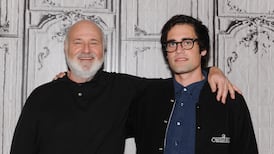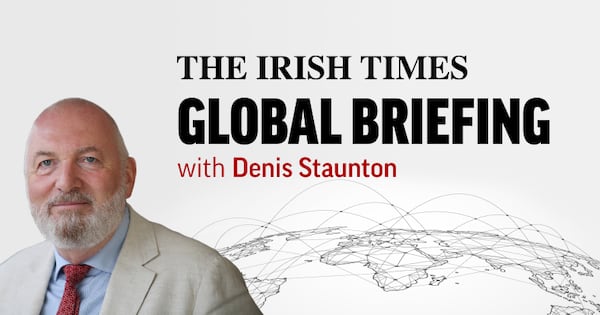The Phantom of the Opera is here.
In 1986, when Michael Crawford, the English sitcom star of Some Mothers Do ‘Ave ‘Em turned West End star, made his debut on Broadway, it turns out that among the afficionados wiping away a tear in the darkened auditorium was the real estate tycoon Donald Trump. He has always found the music of Andrew Lloyd Webber irresistible.
“I was there,” the US president reminisced on Wednesday after naming Crawford among the annual Kennedy Center honorees. Trump was standing in the foyer of the opera house section of the vast auditorium beside the Potomac, which has become symbolic of his intention to leave his mark on the US capital city.
“I shouldn’t say that. It seems like a long time ago,” he said as he named the chosen honorees who belong to a distinct era, demographic and, it appeared, among the preferred tastes of Donald John Trump.
RM Block

He welcomed the country music veteran George Strait to the honorees club. “Good lookin’ guy’ I hope he still looks like that,” Trump said, as a red velvet cover was unveiled to reveal Strait in his Texan prime.
Also there was Sylvester Stallone – and here Trump recalled his amazement at going along to a New York movie theatre one evening “as a young guy” to see “a thing called Rambo when it just came out”.
Gloria Gaynor was honoured, and the New York glam metal veterans Kiss, who have been on the road for half a century, completed the list.
All will be honoured in a gala event in December, by which time the reinvention and recalibration of Washington DC’s cultural institutions will be well under way.
“I would have taken one if they would have called me,” Trump said of the distinction of receiving a Kennedy Center honour.
“I waited and waited and then I said, the hell with ‘em, I’ll become chairman.”

And he did, too. The unveiling of the 2025 honorees cast Trump in the three guises through which the world has come to know him: political firebrand, reality television star and real-estate developer.
He showcased his strange capacity from flitting from minor detail – the gold columns that stood before us in the opera room would, he promised, become magnificent features – to major event (warning that there would be severe consequences for Vladimir Putin if nothing is achieved from Friday’s summit in Alaska) without any obvious distinction of which issue matters most to him.
His Kennedy Center announcement was neatly symbolic of the difference between the first Trump administration and the routing of the Washington establishment which he has initiated since returning to office in January.
Like most public spaces in the city, the Kennedy Center was designed and realised on an enormous, intimidating scale: it resembles an architecturally conscious aircraft hangar from a distance. Its history reflects the old dichotomy that Washington is part political nerve centre of the Western world and part small, sleepy city of the Upper South.

For decades, politicians had flogged themselves over the absence of a cultural hub and it wasn’t until 1958 that a Bill was finally presented to and approved by Congress, marking the first federal funding of a building dedicated to the performing arts.
The National Cultural Center was rededicated as the Kennedy Center in 1964 following the assassination of president John F Kennedy in November 1963. The doors were not opened to the public for the first time until September 1971, with a performance of Leonard Bernstein’s MASS in the Opera House.
Wednesday’s impromptu Trumpian theatre marks the latest chapter in a concerted attempt to reshape an institution which he avoided as one might an angry dog during his first term.
Bright lights of the liberal arts tend to cultivate peskily liberal views and Trump elected to skip the 2017 event, with the White House stating that the decision would “allow honorees to celebrate without political distraction”.
The first couple stayed away for the next three years. Those absences as the cultural elite gathered must have felt like an indirect snub to Trump, and a continuation of the snobbery he encountered during the decades when he became a symbol of New York excess. And he did not forget.
Trump was just weeks returned to the Oval Office when he announced that he was firing the entire Kennedy Center board of trustees. Shortly after that, he appointed himself as chairman. The first announced event was Les Misérables and the spring programme has been tailored to reflect the tastes of the incoming administration, with a line drawn through anything considered “woke”.
Flagging Wednesday’s announcement, Trump again teased his ambition that the building will be renamed after him, writing on Truth Social: “Great nominees for the Trump/Kennedy Center, whoops, I mean, Kennedy Center, awards.”
He went on to say that “tremendous work” has been undertaken to restore it to the “absolute TOP LEVEL of luxury, glamour and entertainment. It had fallen on hard times”.

So, just a day after declaring a public safety emergency and drafting in the National Guard to help police Washington for at least a 30-day period, and just 48 hours before he sits down with Putin in Anchorage for a bilateral meeting with overwhelming geopolitical consequences for Ukraine and, by extension, Europe, president Trump took a timeout to consider the arts.
He presented the Kennedy Center as a symbol of his determination to make Washington safe for the public again, warning people to ignore the official statistics denoting plummeting crime rates.
“We’re going to be essentially crime-free. This is going to be a beacon, and it’s going to also serve as an example of what can be done.”
Trump also confirmed that he will be seeking an extension of the 30-day posting of the National Guard, FBI agents and other personnel drafted in for what the White House has termed an emergency period.
Meanwhile, plans are afoot to change the current name of the Kennedy Centre, with Missouri Republican congressman Bob Onder drafting a Bill to have the place rebranded in honour of the 47th US president.
“You would be hard-pressed to find a more significant cultural icon in the past 40 years than president Trump,” Onder ventured in a statement to support his Bill in July.
Try as he might, Onder said, he could “not think of a more ubiquitous symbol of American exceptionalism in the arts, entertainment and popular culture at large than president Trump.”

Across town, Lonnie Bunch III, secretary of the Smithsonian, received a letter this week from the White House requesting a full list of artefacts and exhibits in all its major museums within 30 days in preparation for next year’s 250th celebrations.
“In this spirit, and in accordance with Executive Order 14253, Restoring Truth and Sanity to American History, we will be leading a comprehensive internal review of selected Smithsonian museums and exhibitions,” the letter stated.
“This initiative aims to ensure alignment with the president’s directive to celebrate American exceptionalism, remove divisive or partisan narratives and restore confidence in our shared cultural institutions.”
The museums will have 120 days to begin “content corrections”, where appropriate.
“They drew first blood, not me,” ‘Sly’ Stallone memorably said in Rambo, when the film was released in October 1982.
Trump may have stored that one away. The reimagining of Washington’s arts scene will be well under way when ‘Sly’ is in town for the December gala to celebrate the Kennedy Center Honorees. Emcee for the evening will be US president Donald J Trump.













